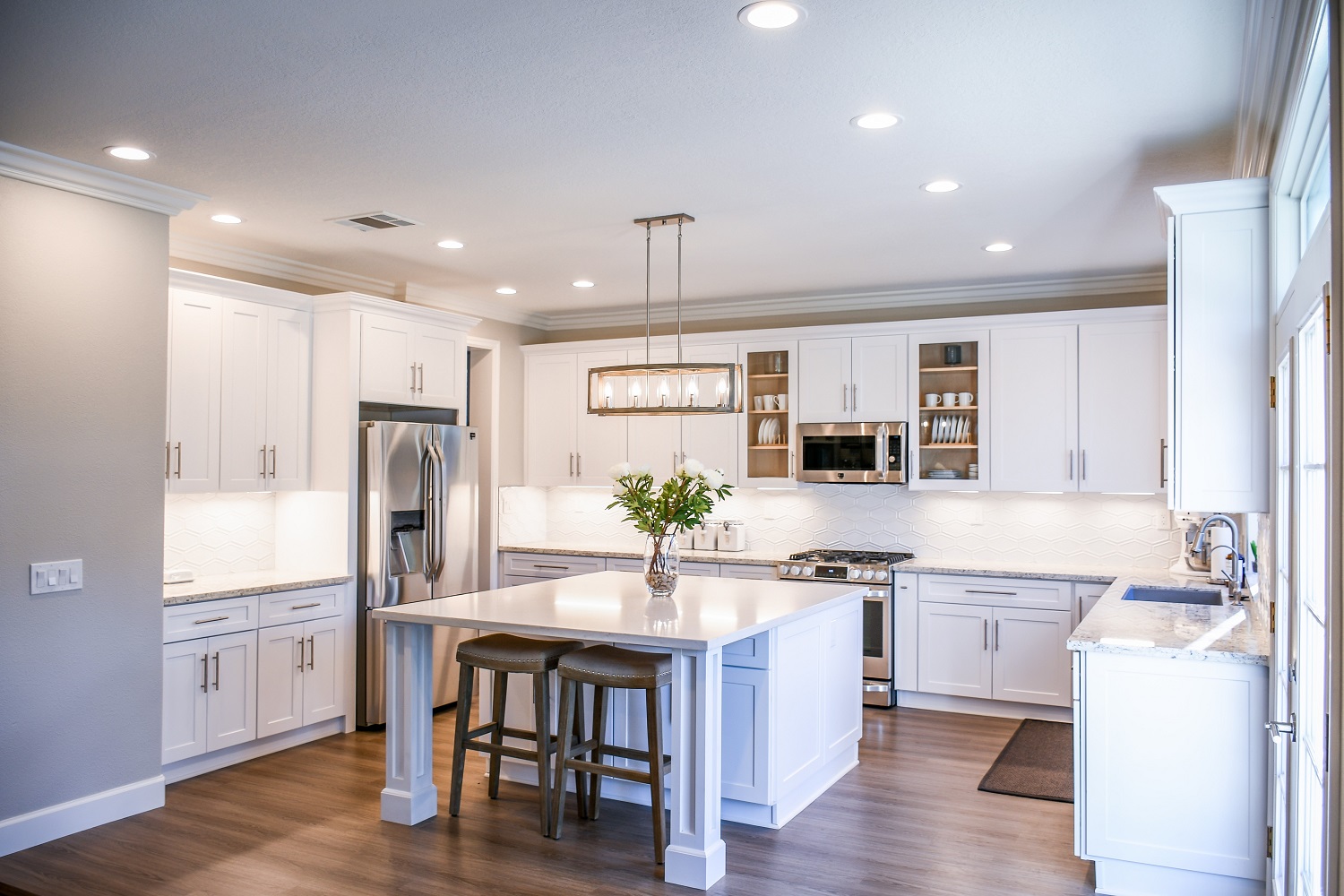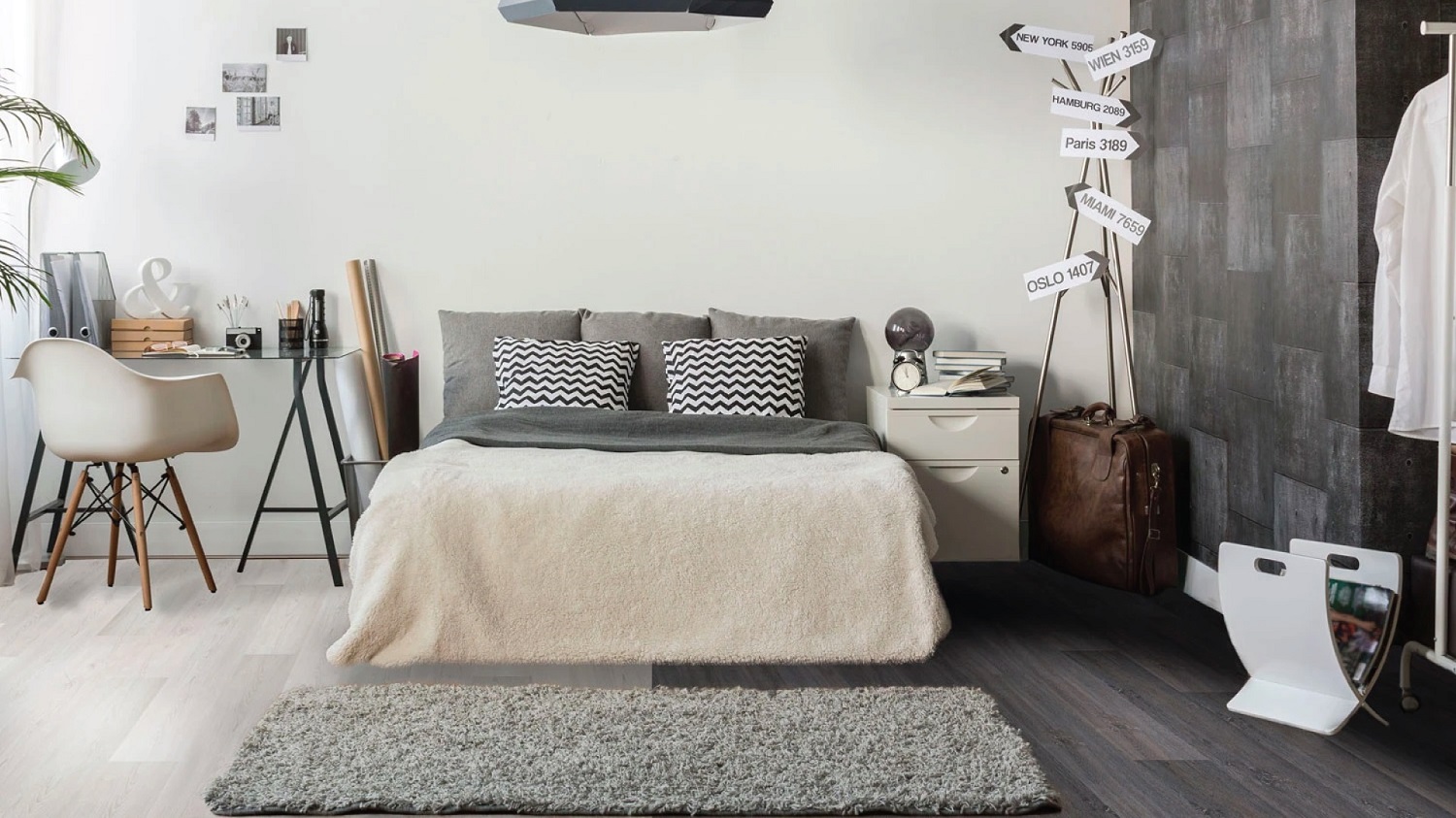Last updated 8/4/24
Most people don’t know what they want and simply want what they know, which means they are more likely to follow trends. When it comes to flooring, some people prefer darker, richer tones, while others prefer lighter shades. Many others have no idea where to start. When you have more information, you can be in the driver’s seat in terms of what will be best for your home long term.
That’s why we compiled our guide to the pros and cons of light vs. dark floorboards, which will help you decide which shade will work best in your home.
Choosing Between Dark & Light Flooring
Here are some questions to ask yourself when considering light vs. dark flooring:
- Is there a certain shade you gravitate toward?
- Do you have pets? Kids & a busy household?
- Does your home have a particular design style? If so, which design style is it?
- How often do you clean? How much does dirt showing matter to you?
- How big is each room?
- How much light does your household get? Is it primarily natural or artificial light?
- What colour are the walls currently (or going to be)?
- What colour are your cabinets?
- What does your furniture look like?
Cleaner-Looking Floor Boards
If disguising dirt is essential to you, light flooring is the clear winner. In general, dirt and debris will be far less noticeable on light floors than in darker tones. This is undoubtedly an advantage for busy households with kids or pets.
However, it is important to consider the most common debris you expect in your home. For example, red dirt will likely show up easier on lighter floors, while sand may blend in more. If your overall debris is lighter (think sand, dust, and pet hair), you may find light floors to be your best bet.
Whether you choose light or dark flooring, follow these tips for minimising how easily dirt shows up:
- Make your household a shoe-free zone (this is a beneficial habit to practice for more reasons than just keeping dirt out)
- Choose a satin finish to help minimise imperfections

Expert Insights From Levi Saunders
Online Retail Specialist & Flooring Content Creator
For some homeowners, spotting dirt more easily on flooring can be advantageous. This might be the case for people with allergies who want to know surfaces are spotless, not just visually. You may miss dirt particles on a white floor that set off allergies.
Light Floorboards Show Less Scratches
Again, light floors have the advantage here. Whether you use timber, vinyl, hybrid, laminate or any other white or dark floorboards, clear coating always shows white when scratched, meaning scratches in darker flooring will show up way more.
If hiding any potential scratches is a high priority to you, lighter flooring will likely be your best bet.
Darker colours magnify scratches and imperfections, especially on dark wooden floors. When the surface is scratched on a dark wood floor, the lighter scratch shows through underneath and contrasts the darker shades on top. In most cases, there are many things you can do to repair and replace damaged or scratched flooring that do not require the help of a professional.
Dark Timber Flooring Considerations
In some cases, being more expensive does not mean fewer potential issues and dark timber flooring comes to mind in this topic. The bottom line is that committing to dark timber flooring will mean lots more regular maintenance to keep it looking nice.
Recently, I spoke to a layer who finished a surface with gloss black. He openly admitted that because of the customer’s choice, he had likely created maintenance work every year for many years to keep it pristine. This rare and exquisite look will ultimately come at a cost to the customer for many years.
The bottom line is that any dark timber flooring product is more likely to show scratching and scuff marks, and potential customers need to be aware of that fact. Some dark timber flooring options just look amazing and are too hard to resist. As they say, beauty requires sacrifice—just ask my wife.

Expert Insights From Clem Sturgess
20+ years' experience in hard flooring
In my old family home, I had a dark chocolate bamboo floor installed. I saw every scratch on my floor. The white scratches were painful for me to look at. I routinely vacuum and mop at least twice a week because dust and dirt would be obvious. In comparison, my neighbours had a light hand-scraped coffee-coloured bamboo floor and saw no scratching or scuff marks on their flooring. The scratches were still there but not visible. They could clean by feel rather than look.
Dark Laminate Floors Scratch Less
If you are looking for a dark floor, laminate will scratch less than any other type of flooring. A product such as Aqua Guard Laminate in the colour Teramo. Another great example is Aqua Schild Laminate in the colour Rostock as another great dark laminate flooring colour variation.
Light Hybrid Flooring Favorite
For light Eclipse Monument Hybrid flooring in Keystone colour is a personal favorite of mine. It has a lovely light & fresh coastal blackbutt flooring look.
Flooring for Dogs and Kids
As you may have gathered from the first two comparisons, lighter flooring will likely be more forgiving in busy households. If you choose darker floors, ask us about the most durable finishes and best flooring options for kids or pets; we’d gladly help. Lighter flooring is also more pet-friendly.
However, both types can be suitable in the right circumstances. For example, a dark laminate will still fair well due to the type of flooring, making it still a kid and pet-friendly option. Remember, though, that dog and animal hair and fur will stand out on a dark floor no matter what.
Do Dark Floors Make a Room Look Smaller?
Yes, dark floorboards do tend to make spaces appear smaller. While this may not be ideal in a home or granny flat with limited space, it can be an excellent feature in larger homes or rooms that you would like to feel more cosy and inviting.
- Lighter floors may be a great option to maximize space in a cramped area. However, a room’s atmosphere and overall impression depend on the combination of flooring, walls, accents, and furniture choices. Don’t limit yourself to light floors if your heart is set on darker tones. Also, remember that area rugs can help unify spaces and bring colour tones together.
- If you prefer dark floors but have concerns that it will make your space seem too dark, consider adding additional overhead lighting, more windows, lighter window treatments, and lighter paint.

Expert Insights From Raquel Billett
Interior Décor Expert
Window coverings that are wall-mounted rather than reveal-mounted can make a room look smaller. For example, if you mount a blind into the reveal of a window, it will not creep into the wall's space. If you put a curtain rod frame over the top of the window opening and that curtain hangs down, it comes into the room's space, bringing it closer visually.
Dark & Light Floors in Sun-Exposed Rooms
We love the sun here in Australia, but it can be brutal on flooring, and we also need an escape from it. Both dark and light floorboards can absorb sunlight and are more prone to fading. Some flooring types fade more than others, but the main factor here is the product quality you are dealing with. Higher-end products are more likely to contain UV-stabilized technology, which can heavily prevent & reduce fading in sun-exposed areas.
That said, most suppliers will never guarantee that their products will not fade. We encourage you to ask whether cheap flooring is an expensive option in the long term.
Visual Impact
In my opinion, in most cases, dark floors make more of an impact and take centre stage. If you want your floors to make a statement, dark shades can offer the impact you want. I know from experience that when people walked into my old home, the chocolate-coloured dark bamboo flooring was more often than not an immediate talking point and wow factor.
Light floors have a subtle way of letting your decor shine as the focal point. Alternatively, dark tones impart a bold, rich atmosphere.
Light floors may be the best choice if you want a classic look that allows your furniture and decor to take centre stage.
Do Light or Dark Tones Show Grain Better?
If you opt for solid timber or engineered timber floors, the darker the stain you put on timber, the more you overpower its natural wood grain appearance. In unique cases, specific wash colours and reactive stains may accentuate a timber’s natural tones somewhat; however, generally, when using a stain, it’s like putting cellophane over the top. The lighter the cellophane, the more you will see the surface’s original tones.
Which Is Trendier?
In 2024, we can confirm the trend toward very light tones, which has been this way for many years. Shades such as Blackbutt, Tasmanian oak, and Bleached Oakes are currently topping the sales list among customer preferences.
Although fewer people want darker floorboards, they come in knowing they want a darker floor, making it a seemingly more refined choice. Tones such as dark-tinted oaks, ironbark and Queensland spotted gum are among the more popular options for dark flooring.
The Importance of Samples
Once you decide between light and dark floors (or if you are still deciding), it can be helpful to obtain colour swatches to see precisely how they will appear in your home.
The lighting in your home — and at certain times of day — will have a significant impact on the appearance of the flooring. Pay attention to how the colours appear throughout the day and in different lighting (artificial vs. natural). You can also see how the flooring works with your furniture, paint, cabinets, and accents.
Matching Kitchen Cabinets
If you are installing floors in your kitchen, living room, or dining room in an open-concept house, you will want to consider the colour of your cabinets.
In general, choosing darker floors with lighter cabinets or lighter floors with dark cabinets offers a nice contrast.

Contrasting floors and cabinets work best in kitchens.
Resale Value
Choosing lighter or darker flooring is not a determining factor for adding value to your home.
However, the following three factors are:
- Type of flooring used – In most cases a timber floor will be more likely to add more value to a home than other flooring types
- Condition of the floor – A floor covered in scrapes & scratches can at the very least subtract from the perceived home value
- Does the flooring type and shade match the style of the house?
Conclusion
Light and dark floors can be beautiful options in various settings.
If you are still deciding which shade would be best for your space, please feel free to contact our experienced team. We aren’t just here to help with the technical aspects; we are happy to help with design as well.




